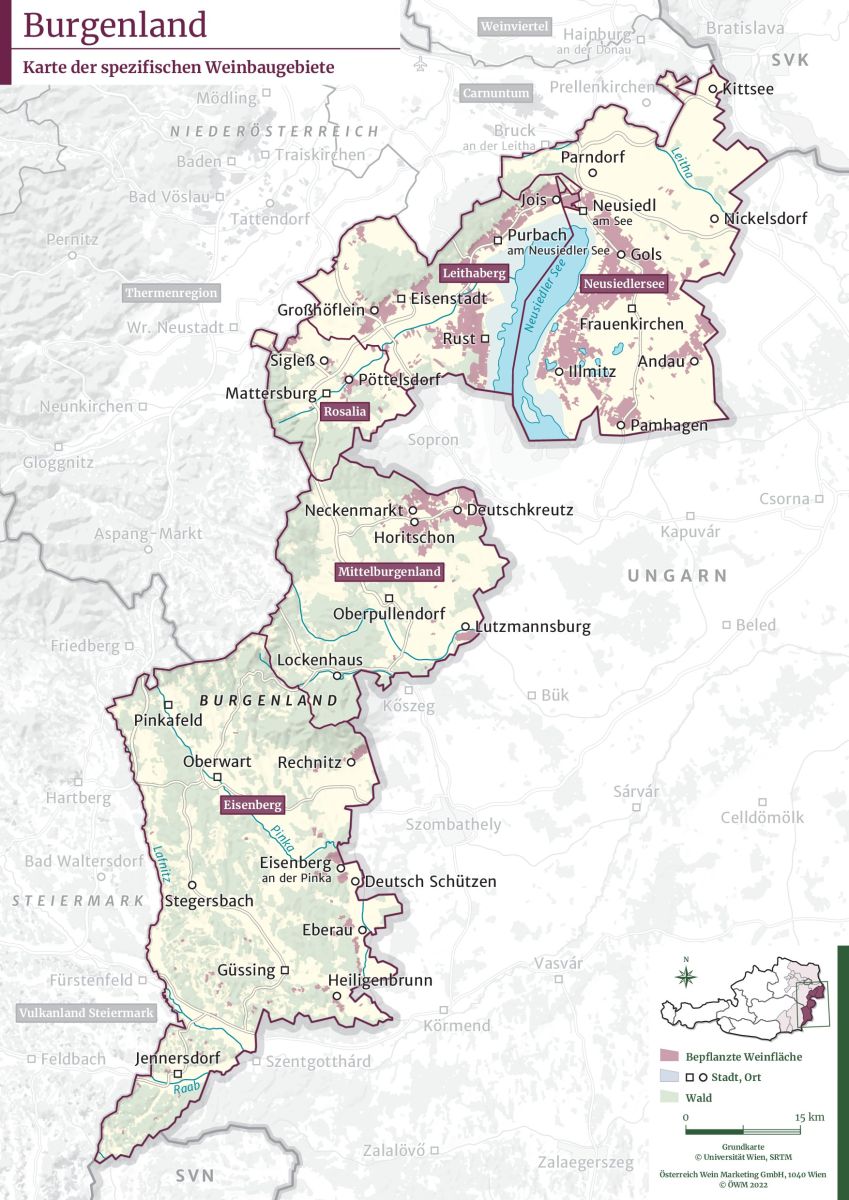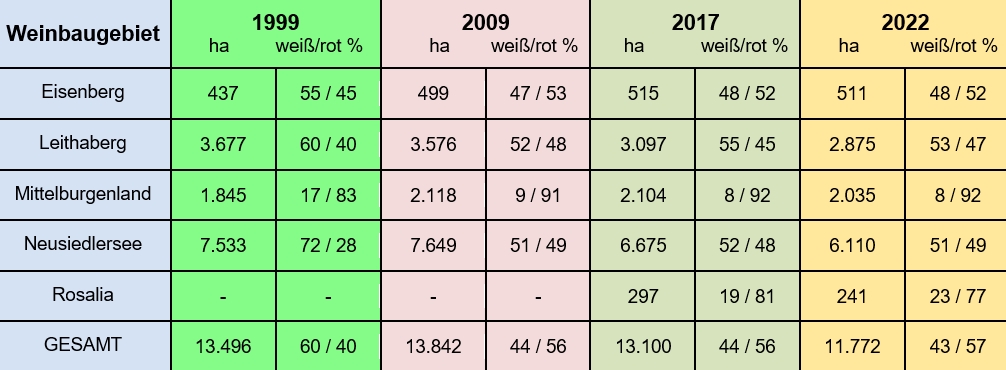Results
2,284 Results
Loading more Results ...
Loading more Results ...
Wine regions in Burgenland 13 growing regions
Description to Burgenland
The federal state of Burgenland with its capital Eisenstadt is located in the very east of Austria. It borders Slovakia to the north, Hungary to the east, Slovenia for a few kilometres to the south and the two Austrian provinces of Lower Austria and Styria to the west. Viticulture has been of great importance here for two and a half millennia, which is underlined by the saying "Extra Pannoniam non es vita; si est vita, non est ita" (Outside Pannonia one cannot live; if one can live, then not like here), originating from the historian Johannes Aventinus (1477-1534). Along with Stillfried in the Weinviertel, Zagersdorf is one of the oldest wine-growing communities in Austria, as grape seeds of the cultivated vine Vitis vinifera were discovered in a Celtic burial mound from the Hallstatt period around 700 BC.
History
In the first century BC, the Romans penetrated as far as the Danube and founded the province of Pannonia (historical landscape in western Hungary, which included today's Burgenland, which only became part of Austria in 1920). A new wine culture was formed when the ban on planting vines was lifted by Emperor Marcus Aurelius Probus (232-282). At that time, Roman legionaries were entitled to three measures of wine per head and day. In 433 AD, the Hun king Attila conquered the province of Pannonia. The turmoil of the migration of peoples had a very negative effect on viticulture. Emperor Charlemagne (742-814) initiated a reconstruction. Among other things, nobler Franconian varieties were introduced and wine from their own vineyards was allowed to be served in the wine taverns.
The greatest merit can be attributed to the Cistercians, who drained and cleared the swampy and wooded area. In 1216 they already cultivated 99 vineyards in Heiligenkreuz (Lower Austria). From here they began to plant more vineyards around Lake Neusiedl, around Marienberg Monastery (near Oberpullendorf) and around St. Gotthard. In the 16th century, the vineyard area had reached its greatest expansion and viticulture had become the most important source of income. The Hungarian Queen Maria (1505-1558) granted great privileges to the Burgenland winegrowers. She granted the wine villages of Rust, Jois and Neusiedl am See the right to mark their wine barrels with the initial letters "R", "G" (for Geusz) and "N". The famous Ruster Ausbruch was created at this time and equated with Tokaj.
Viticulture in modern times
Burgenland was particularly affected by the many Turkish invasions in the 16th and 17th centuries. Despite all the turmoil of war, epidemics, bad weather and other strokes of fate, the period from the 16th to the 18th century was the absolute heyday of Burgenland viticulture, with predominantly white wines being produced at this time. Large quantities were delivered to the imperial court cellar in Vienna and the particularly popular Rust wine was given the honorary title "Vinum imperatorum - imperator vinorum". At that time there were four quality classes in Burgenland: Vinum Nobile (noble wine, dried berries of the Furmint grape variety), Vinum Bonum (quality wine made from the Furmint, Weißer Augster, Blauer Augster and Muskateller varieties), Vinum Mediocre (medium quality) and Vinum Cibale (table wine).
In 1622, Count Nikolaus Esterházy (1583-1645) was granted the dominions of Forchtenstein and Eisenstadt as a fiefdom by Emperor Ferdinand II (1578-1637). This noble family promoted viticulture and wine trade and became the largest landowner in Austria. At the beginning of the 19th century, the Golden Age was over. Due to the Napoleonic Wars and crop failures, large areas of vineyards had to be abandoned and converted into arable land. In the second half of the 19th century phylloxera also struck Burgenland. Paul Vetter from Gols rendered great services in the fight against phylloxera.
Climate & Soils
The area is characterised by a Pannonian-continental climate, the climate-regulating influence of the 230 km² Lake Neusiedl and relatively long growing seasons of up to 250 days. Due to the excellent climatic conditions, Burgenland is ideally suited for viticulture and is considered the red wine region of Austria. The climate and soils in the individual wine-growing regions are quite different and favour certain grape varieties or wine types. The heavy clay soils in Central Burgenland are particularly suitable for red wines, the limestone and slate soils on the Leithagebirge for white wines and the Seewinkel for sweet wines because of the high humidity.

Wine-growing regions
Together with Lower Austria and Vienna, Burgenland forms the wine-growing region Weinland, which serves as an indication of origin for country wines. It used to be divided into four wine-growing regions. In 2016, there was an extensive restructuring with also changes in the boundaries of the wine-growing regions. Only two of them are congruent. The political district of Mattersburg forms the newly created fifth area Rosalia. The two large vineyards Pinkatal and Geschriebenstein were replaced by Großlage Südburgenland. For the Freistadt Rust there is the new sixth DAC area with the special wine type Ruster Ausbruch. For all quality wines, the generic wine-growing region Burgenland must appear on the label; for DAC wines, the DAC designation must also appear. The wine-growing areas with the development of the vineyards:
- Eisenberg - congruent with former Südburgenland.
- Leithaberg - formerly Neusiedlersee-Hügelland, changed boundaries
- Mittelburgenland - identical in name and boundaries
- Neusiedlersee - same name, changed boundaries
- Rosalia (district of Mattersburg - new as of 2016)
- Ruster Ausbruch (municipality of Rust, Leithaberg) - new as of 2016, vineyards are included in Leithaberg

Grape variety list
In 2022, vineyards covered a total of 11,772 hectares of vineyards. Compared to 2017 with 13,100 hectares, this was a reduction of 1,327 hectares (10.1%). Of this, white wine varieties account for 5,044 hectares (43%) and red wine varieties 6,728 hectares (57%). The red wine varieties Blaufränkisch and Zweigelt are in the lead, accounting for about 41%:
Grape variety
|
in Austria
|
Colour |
HA
|
%
|
HA
|
%
|
| Blaufränkisch | - | red | 2.437 | 20,7 | 2.843 | 21,7 |
| Zweigelt | Blue Zweigelt, Rotburger | red | 2.337 | 19,9 | 2.513 | 19,2 |
| Grüner Veltliner | Weißgipfler | white | 1.113 | 9,5 | 1.365 | 10,4 |
| Welschriesling | - | white | 981 | 8,3 | 1.255 | 9,6 |
| Chardonnay | Morillon - not used in Bgld | white | 708 | 6,0 | 657 | 5,0 |
| Merlot | - | red | 487 | 4,1 | 435 | 3,3 |
| White Burgundy | Pinot Blanc, Klevner | white | 440 | 3,7 | 510 | 3,9 |
| Cabernet Sauvignon | - | red | 352 | 3,0 | 365 | 2,8 |
| Sauvignon Blanc | Muscat Sylvaner | white | 321 | 2,7 | 265 | 2,0 |
| St. Laurent | - | red | 290 | 2,5 | 368 | 2,8 |
| Pinot Noir, Pinot Noir | Pinot Noir, Pinot Noir, Pinot Noir | red | 244 | 2,1 | 286 | 2,2 |
| Muscat Ottonel | - | white | 240 | 2,0 | 262 | 2,0 |
| Müller-Thurgau | Rivaner | white | 204 | 1,7 | 300 | 2,3 |
| Muscat Blanc | Yellow M., Red M. / Muscat Blanc | white | 187 | 1,6 | 137 | 1,0 |
| Bouvier | - | white | 184 | 1,6 | 187 | 1,4 |
| Roesler | - | red | 142 | 1,2 | 128 | 1,0 |
| Scheurebe | seedling 88 | white | 123 | 1,0 | 157 | 1,2 |
| Syrah | Shiraz | red | 108 | 0,9 | 114 | 0,9 |
| White Riesling | Riesling, Rhine Riesling | white | 93 | 0,8 | 133 | 1,0 |
| Traminer | Gewürztraminer, Red T., Yellow T. | white | 84 | 0,7 | 106 | 0,8 |
| Grey Burgundy | Pinot Gris, Ruländer | white | 81 | 0,7 | 77 | 0,6 |
| Neuburger | - | white | 77 | 0,7 | 139 | 1,1 |
| Cabernet Franc | - | red | 76 | 0,6 | 59 | 0,5 |
| Blauburger | - | red | 72 | 0,6 | 112 | 0,9 |
| Rathay | - | red | 25 | 0,2 | 23 | 0,2 |
| Furmint | - | white | 24 | 0,2 | 11 | 0,1 |
| Gold muscatel | - | white | 21 | 0,2 | - | - |
| Goldburger | - | white | 15 | 0,1 | 48 | 0,4 |
| Flower muscatel | - | white | 12 | 0,1 | - | - |
| Muscaris | - | white | 9 | 0,1 | - | - |
| Souvignier gris | - | white | 6,2 | 0,1 | - | - |
| Rose muscatel | - | red | 3,8 | - | - | - |
| Frühroter Veltliner | Malvasia | white | 3,3 | - | 13 | 0,1 |
| Blue Portugieser | - | red | 1,1 | - | 11 | 0,1 |
| Sylvaner | Green Sylvaner | white | 0,9 | - | 2 | - |
| Rotgipfler | - | white | 0,6 | - | 1 | - |
| Roter Veltliner | - | white | 0,6 | - | 0,5 | - |
| Zierfandler | Late red | white | 0,6 | - | 0,3 | - |
| Jubilee Vine | - | white | 0,1 | - | 3,5 | - |
| Blue Wildbacher | - | red | 0,1 | - | - | - |
| other varieties | - | white | 486 | 9,6 | 81 | 0,6 |
WHITE SORT |
|
white |
5.044 |
43 |
5.818 |
44 |
RED SORT |
|
red |
6.728 |
57 |
7.282 |
56 |
TOTAL |
|
|
11.772 |
|
13.100 |
|
Producers
Well-known Burgenland winegrowers' cooperatives and winegrowers' associations are Eichenwald Weine, Pannobile, Pannonischer Reigen, Renommierte Weingüter Burgenland (RWB), Weinidylle Südburgenland and Winzerkeller Neckenmarkt. The most famous wineries are listed with the individual wine-growing regions.
Map: © ÖWM
Classified wine producers in Burgenland 93
find+buy for Burgenland 75
Recent wines 4597
 Hammer Wein Rust - Mag. Markus Hammer
— Burgenland
2021 "ZERO"
88 WP
very good
18.00 €
Hammer Wein Rust - Mag. Markus Hammer
— Burgenland
2021 "ZERO"
88 WP
very good
18.00 €

 Weingut Weninger GmbH
— Burgenland
2013 Mittelburgenland Ried Dürrau Blaufränkisch trocken
Weingut Weninger GmbH
— Burgenland
2013 Mittelburgenland Ried Dürrau Blaufränkisch trocken

The most important grape varieties
More information in the magazine
- Wines with a special flavour Wine-growing regions in Austria: Eisenberg
- The land of Blaufränkisch Wine-growing regions in Austria: Mittelburgenland
- Delightful border region Wine-growing regions in Austria: Rosalia
- In Focus: Grüner Veltliner The elegant ones are coming
- Terroir and landscapes in Burgenland At the centre of the Blaufränkisch universe
- BEST OF Burgenland Much new on old shores
- Austria In Focus Burgenland
- Mittelburgenland DAC Fruity, spicy, unmistakable Blaufränkisch
- Travel diary Burgenland Travel diary Burgenland
- The collections and discoveries of the year Tasting season 2023/2024

